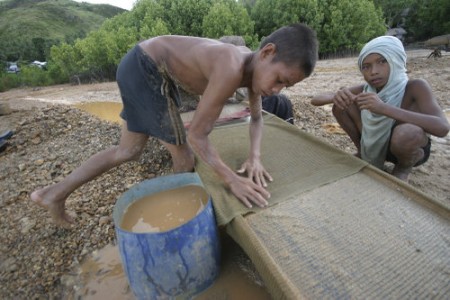 These two boys in Indonesia you see here (and in the video below) are part of some 600,000 children who work as artisanal gold miners around the world. These children help their poor families earn a meager living by processing bits of ore for tiny pieces of gold in small family-run operations.
These two boys in Indonesia you see here (and in the video below) are part of some 600,000 children who work as artisanal gold miners around the world. These children help their poor families earn a meager living by processing bits of ore for tiny pieces of gold in small family-run operations.
Every day, the children touch and inhale large amounts of toxic mercury, which is burned off in the gold extraction process. In some instances, a dangerous hybrid processing technique that includes both mercury and cyanide is used.
Worldwide, some 15 million artisanal gold miners, including 4.5 million women and 600,000 children, are poisoned by direct contact with toxic mercury.  In addition, mercury rises and travels, dropping into rivers, oceans and seas, contaminating seafood far and wide. A recent UNEP report “Mercury: Time to Act” points to the rising threat of mercury, noting that the amount of mercury in the top 100 meters of the world’s oceans has doubled over the past century.
UNIDO (The United Nations Industrial Development Organization)Â estimates that artisanal gold mining results in the release of an estimated 1,000 tons of toxic mercury per year, which constitutes about 30 percent of the world’s mercury emissions. Â At least a quarter of the world’s total gold supply comes from artisanal gold mining.
Blacksmith has been working to help reduce mercury emissions from artisanal gold mining in Indonesia and other countries by introducing mercury recapturing retorts to miners. Blacksmith has also been exploring the use of the borax method – a century-old technique used by some Filipino gold miners that processes gold without the use of toxic mercury.